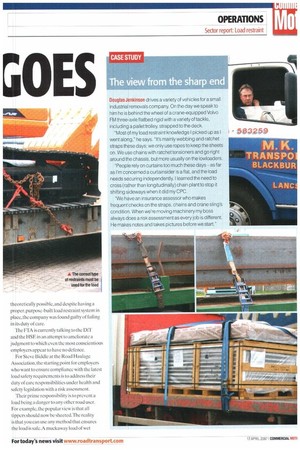STEADY AS SHE
Page 50

Page 51

If you've noticed an error in this article please click here to report it so we can fix it.
[O ES '
Insecure loads kill people, and since the earliest days of road haulage drivers have had to know how to keep things in place. But rising speeds and weights have brought rising risks
— so if you want to stay in the
business you'd better take this subject very seriously indeed.
Dave Young reports.
Little more than a generation ago, load security wasn't what you would call complex. First the load went onto a taulier's ubiquitous, flexible and thankfully heap flatbed trailer or rigid.Then the driver overed it with a stout tarpaulin —to protect he customer's goods against the weather followed by carefully dollied ropes to stop he freight falling off and striking unfortunate cdestrians on corners Extra-heavy loads were 'dogged and chained' iith primitive tensioners, which is why many 'der drivers are missing their front teeth. Before the advent of the all-conquering urtainsider, many commodities were andballed into boxvans where they were sually stacked tight and held in by their wn weight. Furniture might have been ished to side rails with webbing, and a iminishing cargo could have been braced with a couple of crossbars after each drop. If a load fell off the back of a lorry, the driver usually got the sack, his employer paid more for his insurance and everyone put it down to had luck.
Heavy regulation I ialcyon days, but long gone.The number of government agencies with something to say on the subject is almost as numerous as the bewildering choice of load-restraining devices. Factor in the legion of laws,precedents, advice notes, guidelines, codes of practice, risk assessments and other forms of bureaucracy. and load security is a potential nightmare for everyone in road haulage.
According to Geoff Day at the Freight Transport Association (FTA), tit ings went horribly wrong towards the end of last year following a court case when the health and safety ground rules changed.A CV involved in an accident causing injury is seen by the Health and Safety Executive (HSE) as a place of work.After an accident in which a van's load shifted, the operator was prosecuted. Because the vehicle had hit a stationary object deceleration forces were in excess of 20kg. As Day points out, it's almost impossible to restrain anything in these circumstances, even at speeds as low as 30mph.
The court case hinged upon whether a risk assessment had been made; whether there was a complete inventory (tithe equipment on the vehicle; and what load securing and restraint instructions had been given to the driver the key question being, was it possible to restrain the load in any other way?
An operator could surround every crate with RS.Is bolted to the floor, but this is neither customary nor practicable. But because it is theoretically possible, and despite having a proper, purpose-built load restraint system in place, the company was found guilty of failing in its duty of care.
The FTA is currently talking to the DIY and the HSE in an attempt to ameliorate a judgment to which even the most conscientious employers appear to have no defence.
For Steve Biddle at the Road Haulage Association, the starting point for employers who want to ensure compliance with the latest load safety requirements is to address their duty of care responsibilities under health and safety legislation with a risk assessment.
Their prime responsibility is to prevent a load being a danger to any other road user. For example, the popular view is that all tippers should now be sheeted.The reality is that you can use any method that ensures the load is safe.A muckawav load of wet


















































































































































































